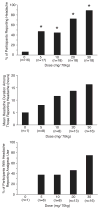Psilocybin dose-dependently causes delayed, transient headaches in healthy volunteers
- PMID: 22129843
- PMCID: PMC3345296
- DOI: 10.1016/j.drugalcdep.2011.10.029
Psilocybin dose-dependently causes delayed, transient headaches in healthy volunteers
Abstract
Background: Psilocybin is a well-characterized classic hallucinogen (psychedelic) with a long history of religious use by indigenous cultures, and nonmedical use in modern societies. Although psilocybin is structurally related to migraine medications, and case studies suggest that psilocybin may be efficacious in treatment of cluster headache, little is known about the relationship between psilocybin and headache.
Methods: This double-blind study examined a broad range of psilocybin doses (0, 5, 10, 20, and 30 mg/70 kg) on headache in 18 healthy participants.
Results: Psilocybin frequently caused headache, the incidence, duration, and severity of which increased in a dose-dependent manner. All headaches had delayed onset, were transient, and lasted no more than a day after psilocybin administration.
Conclusions: Possible mechanisms for these observations are discussed, and include induction of delayed headache through nitric oxide release. These data suggest that headache is an adverse event to be expected with the nonmedical use of psilocybin-containing mushrooms as well as the administration of psilocybin in human research. Headaches were neither severe nor disabling, and should not present a barrier to future psilocybin research.
Copyright © 2011 Elsevier Ireland Ltd. All rights reserved.
Figures



References
-
- Afridi SK, Kaube H, Goadsby PJ. Glyceryl trinitrate triggers premonitory symptoms in migraineurs. Pain. 2004;110:675–680. - PubMed
-
- Aghajanian GK. Mescaline and LSD facilitate the activation of locus coeruleus neurons by peripheral stimuli. Brain Res. 1980;186:492–498. - PubMed
-
- Aghajanian GK, Hailgler HJ. Hallucinogenic indoleamines: preferential action upon presynaptic serotonin receptors. Psychopharmacol Commun. 1975;1:619–629. - PubMed
-
- Aghajanian GK, Marek GJ. Serotonin model of schizophrenia: emerging role of glutamate mechanisms. Brain Res. 2000;31:302–312. - PubMed
-
- Aghajanian G. LSD and phenethylamine hallucinogens: common sites of neuronal action. In: Pletscher A, Ladewig D, editors. 50 Years of LSD. Current Status and Perspectives of Hallucinogens. Parthenon; New York: 1994. pp. 27–42.
Publication types
MeSH terms
Substances
Grants and funding
LinkOut - more resources
Full Text Sources
Other Literature Sources
Medical

